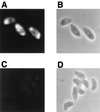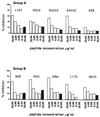Transformed Toxoplasma gondii tachyzoites expressing the circumsporozoite protein of Plasmodium knowlesi elicit a specific immune response in rhesus monkeys
- PMID: 10085003
- PMCID: PMC96513
- DOI: 10.1128/IAI.67.4.1677-1682.1999
Transformed Toxoplasma gondii tachyzoites expressing the circumsporozoite protein of Plasmodium knowlesi elicit a specific immune response in rhesus monkeys
Abstract
Toxoplasma gondii tachyzoites were transformed with the coding sequence of the circumsporozoite (CS) protein of the primate malaria parasite Plasmodium knowlesi. A single inoculation of live transformed tachyzoites elicited an antibody response directed against the immunodominant repeat epitope (EQPAAGAGG)2 of the P. knowlesi CS protein in rhesus monkeys. Notably, these animals failed to show a positive serum conversion against T. gondii. Antibodies against Toxoplasma antigens were detected only after a second inoculation with a higher number of transformed tachyzoites. This boost induced an increased antibody response against the P. knowlesi CS protein associated with immunoglobulin class switching, thus demonstrating the establishment of immunological memory. These results indicate that the Toxoplasma-derived CS protein is efficiently recognized by the monkey immune system and represents an immunodominant antigen in transformed parasites.
Figures






Similar articles
-
Protection of rhesus macaques against lethal Plasmodium knowlesi malaria by a heterologous DNA priming and poxvirus boosting immunization regimen.Infect Immun. 2002 Aug;70(8):4329-35. doi: 10.1128/IAI.70.8.4329-4335.2002. Infect Immun. 2002. PMID: 12117942 Free PMC article.
-
Immunogenicity of the nonrepetitive regions of the circumsporozoite protein of Plasmodium knowlesi.Am J Trop Med Hyg. 1996 Dec;55(6):635-41. doi: 10.4269/ajtmh.1996.55.635. Am J Trop Med Hyg. 1996. PMID: 9025690
-
Genetic Diversity and Natural Selection of the Plasmodium knowlesi Circumsporozoite Protein Nonrepeat Regions.PLoS One. 2015 Sep 17;10(9):e0137734. doi: 10.1371/journal.pone.0137734. eCollection 2015. PLoS One. 2015. PMID: 26379157 Free PMC article.
-
A4D12 monoclonal antibody recognizes a new linear epitope from SAG2A Toxoplasma gondii tachyzoites, identified by phage display bioselection.Immunobiology. 2010;215(1):26-37. doi: 10.1016/j.imbio.2009.01.008. Epub 2009 Mar 3. Immunobiology. 2010. PMID: 19261354
-
[Study and application of surface antigen in tachyzoites of Toxoplasma gondii].Zhongguo Xue Xi Chong Bing Fang Zhi Za Zhi. 2014 Dec;26(6):687-9. Zhongguo Xue Xi Chong Bing Fang Zhi Za Zhi. 2014. PMID: 25856903 Review. Chinese.
Cited by
-
Toxoplasma depends on lysosomal consumption of autophagosomes for persistent infection.Nat Microbiol. 2017 Jun 19;2:17096. doi: 10.1038/nmicrobiol.2017.96. Nat Microbiol. 2017. PMID: 28628099 Free PMC article.
-
Role of Toxoplasma gondii Chloroquine Resistance Transporter in Bradyzoite Viability and Digestive Vacuole Maintenance.mBio. 2019 Aug 6;10(4):e01324-19. doi: 10.1128/mBio.01324-19. mBio. 2019. PMID: 31387907 Free PMC article.
-
Toxoplasma gondii: the model apicomplexan.Int J Parasitol. 2004 Mar 9;34(3):423-32. doi: 10.1016/j.ijpara.2003.12.009. Int J Parasitol. 2004. PMID: 15003501 Free PMC article. Review.
-
Plasmodium falciparum pre-erythrocytic stage vaccine development.Malar J. 2020 Feb 3;19(1):56. doi: 10.1186/s12936-020-3141-z. Malar J. 2020. PMID: 32013956 Free PMC article. Review.
-
Towards Innovative Design and Application of Recombinant Eimeria as a Vaccine Vector.Infect Immun. 2020 Apr 20;88(5):e00861-19. doi: 10.1128/IAI.00861-19. Print 2020 Apr 20. Infect Immun. 2020. PMID: 32094255 Free PMC article. Review.
References
-
- Achbarou A, Mercereau Puijalon O, Sadak A, Fortier B, Leriche M A, Camus D, Dubremetz J F. Differential targeting of dense granule proteins in the parasitophorous vacuole of Toxoplasma gondii. Parasitology. 1991;3:321–329. - PubMed
-
- Aidoo M, Lalvani A, Whittle H C, Hill A V, Robson K J. Recombinant vaccinia viruses for the characterization of Plasmodium falciparum-specific cytotoxic T lymphocytes: recognition of processed antigen despite limited re-stimulation efficacy. Int Immunol. 1997;9:731–737. - PubMed
-
- Allsopp C E, Plebanski M, Gilbert S, Sinden R E, Harris S, Frankel G, Dougan G, Hioe C, Nixon D, Paoletti E, Layton G, Hill A V. Comparison of numerous delivery systems for the induction of cytotoxic T lymphocytes by immunization. Eur J Immunol. 1996;26:1951–1959. - PubMed
-
- Ballou W R, Hoffman S L, Sherwood J A, Hollingdale M R, Neva F A, Hockmeyer W T, Gordon D M, Schneider I, Wirtz R A, Young J F, et al. Safety and efficacy of a recombinant DNA Plasmodium falciparum sporozoite vaccine. Lancet. 1987;1:1277–1281. - PubMed
-
- Black M, Seeber F, Soldati D, Kim K, Boothroyd J C. Restriction enzyme-mediated integration elevates transformation frequency and enables co-transfection of Toxoplasma gondii. Mol Biochem Parasitol. 1995;74:55–63. - PubMed
Publication types
MeSH terms
Substances
LinkOut - more resources
Full Text Sources
Other Literature Sources

